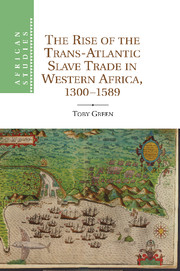Book contents
- Frontmatter
- Contents
- List of Maps
- Acknowledgements
- Abbreviations
- Glossary
- Introduction Rethinking the Trans-Atlantic Slave Trade from a Cultural Perspective
- Part One The Development Of An Atlantic Creole Culture In Western Africa, Circa 1300–1550
- 1 Culture, Trade and Diaspora in Pre-Atlantic Western Africa
- 2 The Formation of Early Atlantic Societies in Senegambia and Upper Guinea
- 3 The Settlement of Cabo Verde and Early Signs of Creolisation in Western Africa
- 4 The New Christian Diaspora in Cabo Verde and the Rise of a Creole Culture in Western Africa
- 5 The New Christian/Kassanké Alliance and the Consolidation of Creolisation
- Part Two Creolisation And Slavery
- Bibliography
- Index
5 - The New Christian/Kassanké Alliance and the Consolidation of Creolisation
from Part One - The Development Of An Atlantic Creole Culture In Western Africa, Circa 1300–1550
Published online by Cambridge University Press: 05 November 2011
- Frontmatter
- Contents
- List of Maps
- Acknowledgements
- Abbreviations
- Glossary
- Introduction Rethinking the Trans-Atlantic Slave Trade from a Cultural Perspective
- Part One The Development Of An Atlantic Creole Culture In Western Africa, Circa 1300–1550
- 1 Culture, Trade and Diaspora in Pre-Atlantic Western Africa
- 2 The Formation of Early Atlantic Societies in Senegambia and Upper Guinea
- 3 The Settlement of Cabo Verde and Early Signs of Creolisation in Western Africa
- 4 The New Christian Diaspora in Cabo Verde and the Rise of a Creole Culture in Western Africa
- 5 The New Christian/Kassanké Alliance and the Consolidation of Creolisation
- Part Two Creolisation And Slavery
- Bibliography
- Index
Summary
By the middle of the sixteenth century, many of the themes that have emerged over the first half of this book had coalesced. The Kriolu language developed on Cabo Verde at the turn of the sixteenth century had been taken to the African mainland by landowners and slaves of landowners on the islands, and, increasingly, New Christian merchants. There, the Creole society emerging in Cabo Verde interacted with a far older set of communities in which plural identities were the norm, and it was from this interaction that an Atlantic Creole culture in Western Africa was consolidated.
The aim of this chapter is to bring together the two main strands which have characterised the first part of this book. Chapters 1 and 2 looked at the influence of trans-Saharan trade and diasporas of merchants in shaping cultural accommodations and political environments in Upper Guinea; they showed how a culture of receptivity towards outsider traders emerged among groups such as the Kassanké, and how this cultural accommodation was influential in the very first African-European connections in the Atlantic in the late fifteenth century. Chapters 3 and 4 then looked at how Atlantic trade based around Cabo Verde became integrated into this picture through the activities of New Christian diaspora traders, and how these developments accompanied the rise of an early form of Creole society on the islands; these chapters further showed how the economic infrastructure underpinning this process depended on slavery and was associated with ideological changes connected to an early form of modernity. In this chapter, we now see the way in which these New Christian diaspora traders built alliances with the Kassanké by the mid-sixteenth century, and how this consolidated a mixed cultural identity and a shared Kriolu language spreading across the Western African region.
- Type
- Chapter
- Information
- Publisher: Cambridge University PressPrint publication year: 2011



